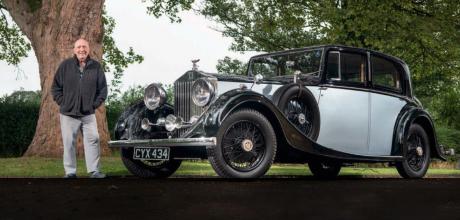1936 Rolls-Royce 25/30 Sports Saloon
Brian Williams came late to the joys of Rolls-Royce ownership. Magnificently capturing the elegance of pre-war luxury motoring, this 25/30hp Sports Saloon has produced a convert with a mission.
WORDS: DAVID WATT
PHOTOS: ADE BRANNAN
ELEGANCE AND QUALITY
Bought to enjoy, just before lockdown kicked in!
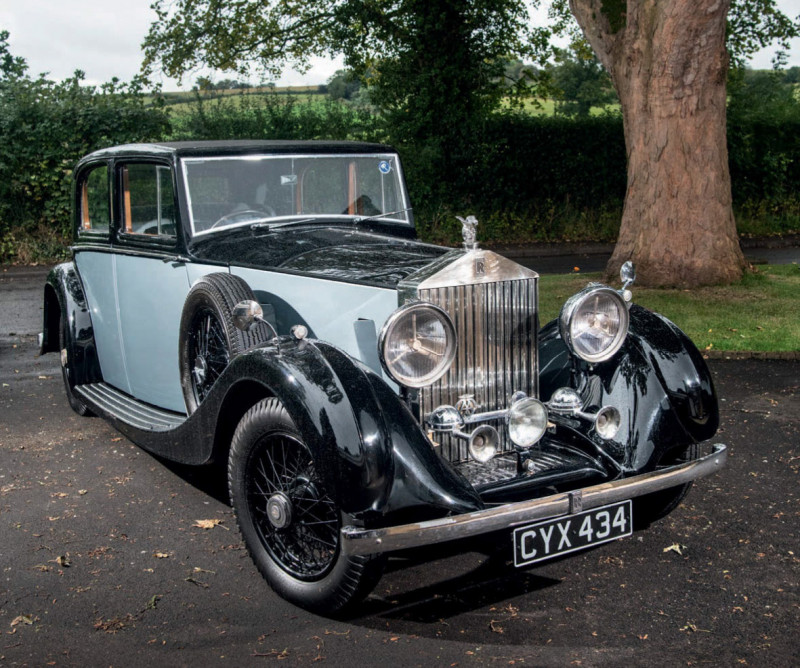
Next time you find yourself in Staffordshire, you may be lucky enough – if you keep your eyes peeled – to catch a glimpse of this lovely and very original car, the pride and joy of Brian and Judy Williams. It’s a 1936 4 ¼ litre Rolls-Royce 25/30hp Sports Saloon (chassis number GTL68) with bodywork by the famous coachbuilders, H.J. Mulliner. The 25/30 was launched in April of ’36 as the latest update to the smaller Rolls- Royce offering that dated back to the introduction of the 20hp model in 1922. Changes from the 20/25 were not extensive, but the increase in engine size from the previous 3.7-litres gave a useful boost to a chassis asked to carry heavier and heavier coachwork. This example was bought from The Real Car Co. in the spring of 2020, and the Williamses had been looking forward to spending the following summer months bonding with their new purchase by exploring the highways and by-ways of their native county. These hopes were soon dashed when the Covid pandemic took hold across the country (across the world, indeed), curtailing the motoring hopes of so many of us during that year. Happily, three years on, Brian and Judy’s plans are back on track, but more of that later.
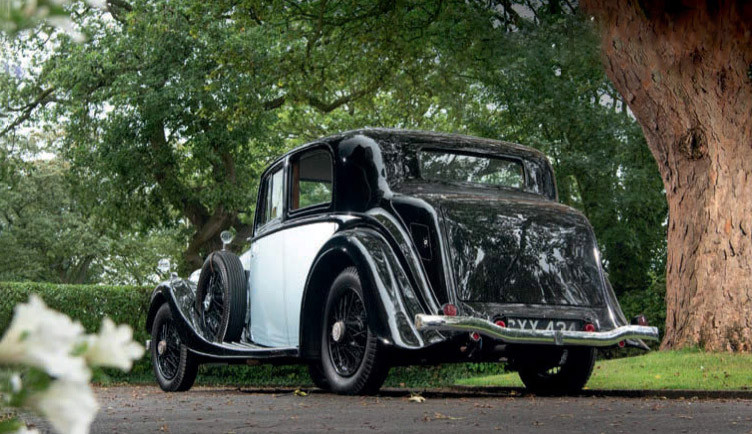
“...the sheer torque of the engine lets you gather speed smoothly from anything above 15mph.”
First, some history. The Williamses are the 11th owners of CYX 434. There are significant gaps in the car’s known history and Brian has embarked on a mission to delve deep into the records, determined that his research will uncover as much as possible of the car’s story. What is known is that the car was bought new in London by a gentleman named Thomas Levington-Jacks who was a director of the Anglo Persian Oil Company which later became British Petroleum (BP). He kept the car for four or five years. During World War Two it was owned by the well-known dance band leader Lloyd Shakespeare and his wife, the actress Betty Warren who, amongst other roles, appeared in the Ealing comedy Passport to Pimlico. Lloyd also owned a motor boat which saw action during the conflict by making three separate trips to France as part of the Dunkirk evacuation operation. Much later, during the 1980s, CYX 434 was based in South Africa, but how it came to be in that country and who owned it there is one of the mysteries waiting to be solved. Brian’s research continues and it is certain that many interesting facts remain to be uncovered.
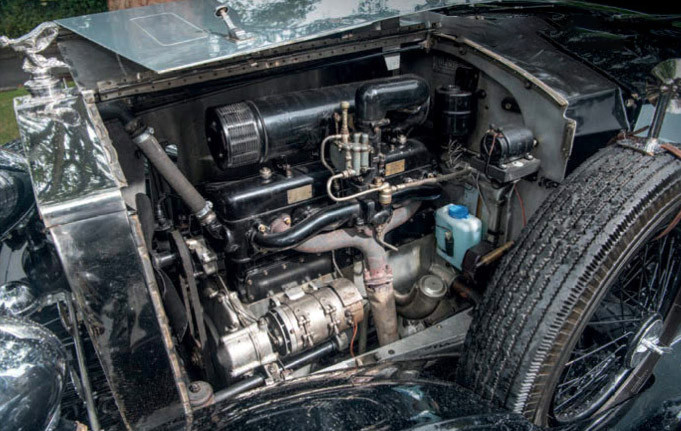
The bodywork is all as per 1936 and retains such original features as a pair of Lucas P100 headlamps, two wing-mounted spare wheels, a rota-flare fog (or spot) light positioned in the centre of the radiator grille and twin, impressively long trumpet horns. These, along with that magnificent Rolls- Royce radiator, produce a purposeful demeanour. This car means business. An interesting feature is the kneeling Spirit of Ecstasy on the radiator, more usually seen on the post-war Silver Dawn model. Brian thinks this was introduced in 1936 to complement a slightly lower bonnet line brought in that year for this model. This would have been viewed as quite a modern update on the traditional mascot and also has the advantage of not requiring to be turned through 90 degrees before the bonnet can be opened. Not original, but rather unusual and very striking, is the two-tone colour scheme of black over pale blue, the result, Brian believes, of a later re-spray.
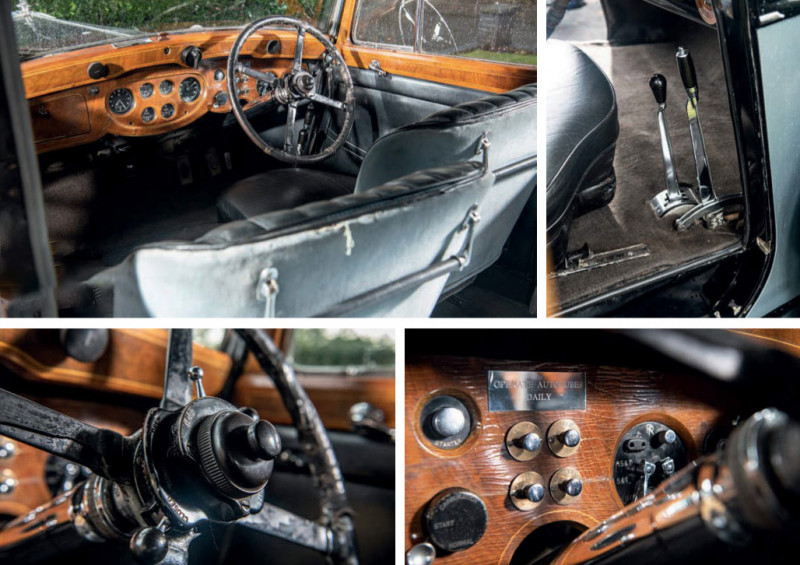
The only external alteration is the addition of extra lights positioned on the rear bumper, introduced for safety reasons. These are themselves old items which fit very well with the age of the car. All the original lights, including the trafficators, are still in perfect working order. Interestingly, no additional indicators have been added to the front of the vehicle, an adaptation many of us would expect to see these days.
Inside, there is attractive pale blue cloth to the rear seats (probably original, says Brian) which match the blue of the exterior lower panels. The black leather covering the front seats has probably been renewed at some stage. The central dashboard, which Brian had stripped and re-lacquered in 2020, features the usual in-period instrumentation: large clock on the left, four gauges in the centre (petrol, amps, oil pressure and water temperature) and speedometer to the right. Above these, just below the windscreen, are knobs to engage the wiper arms and the switch for the trafficators. In front of the driver to the right of the steering column is the usual Rolls-Royce ‘roundel’ containing the lever switch for the lights, a socket for the engine bay torch and the ignition switch. To the left of the steering column are the manual choke and the starter button, while in the middle of this panel are four small chrome knobs labelled ‘Centre’, ’Wiper’, ‘Reverse’ and ‘Headlamp’ which, respectively, operate the front central Rota-flare lamp, the windscreen wipers, the reversing light and the headlamps (separate from the lights switch in the ‘roundel’ and thought to be the full beam/dipped beam control, now inoperable).
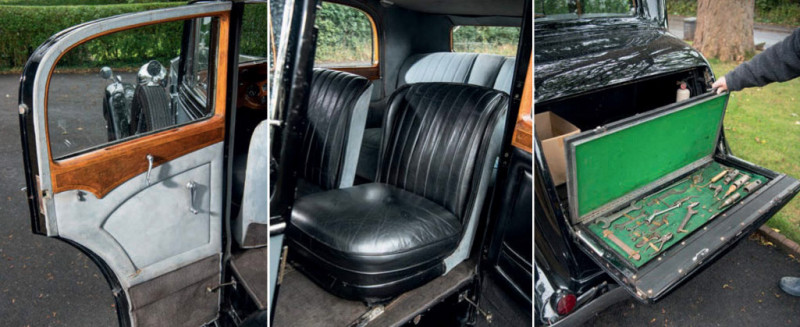
On the veneered door caps on the front doors are small winders which open the quarterlight windows, while a longer lever on the driver’s door card below raises and lowers the window in one go. As was usual for Rolls-Royces and Bentleys of the period, the gear lever and handbrake are floor-mounted to the right of the cut-away driver’s seat. These make getting in and out of the vehicle rather a tricky proposition, so many owners elect to use the passenger door instead and sidle across, though the two separate front seats here (instead of a bench seat) possibly require another level of dexterity.
On the steering wheel boss are the usual controls one expects in a prewar car: hand throttle on the left, ride setting at the top and ignition advance and retard on the right. All work perfectly. Brian is always delighted to show people the starting procedure, revelling in the look on novices’ faces when he explains that the key is used only for locking and unlocking the doors, not for starting the engine. Instead, you twist the choke to the ‘up’ position, move the throttle control to ‘open’, advance the ignition (one o’clock position) and then press the starter button. Brian says she always starts on the button, the 4. litre engine soon settling down to a gentle burble. He normally lets her warm up for a couple of minutes or so before moving off. On acquiring the car, Brian – who also owns a 1935 Austin Ulster, a 1959 Austin Healey 3000 and a 2004 Bentley Continental – says he was immediately struck by the power and torque of the engine.
‘I soon got used to moving up the gears as soon as possible and settling into top where the sheer torque of the engine lets you gather speed smoothly from anything above 15mph. Once you’re in top you can virtually stay there all day. It was quite a revelation.’
He also had to get used to the crossply tyres (new ones were fitted in 2020) which require frequent correction in order to hold the best line. ‘It’s all second nature now,’ he says. Brian particularly likes the firm and predictable clutch action which, coupled with the solid, mechanical gear change, results in smooth changes up and down. There is synchromesh on 3rd and 4th gears. Many drivers of these cars will double de-clutch but, in truth, it is not necessary with the advent of self-synchronising gears. This must have been another revelation to drivers in the 1930s. The ride on these magnificent cars always takes people by surprise, being thoroughly modern in its smoothness and quietness. ‘She just glides along smoothly with no rattles or creaks,’ says Brian. ‘Every trip, this never fails to impress me.’ He takes care to remember to operate the floor-mounted chassis lubrication pedal on start-up and every 50 miles thereafter on longer journeys. He keeps the radiator shutters closed on starting the car and while warming up, gradually opening them through the manual control after a few miles. On warm days, that is; on cold days, they remain closed.
But perhaps the greatest pleasure Brian and Judy have derived from ownership is the many friends they have made since acquiring the car, not only through membership of the Rolls-Royce Enthusiasts’ Club but also through having the car professionally maintained by Chris Shenton Engineering based in Hanford. Chris has become a close family friend, often going on fly fishing outings with Brian. With the removal of most pandemic restrictions, he hopes that 2023 will see the car get much more regular use, especially for runs to raise funds for the various local charities he is involved with. Brian is an enthusiast in the true sense of the word. While admitting to coming late to the joys of pre-war Rolls-Royce ownership, Brian certainly enjoys all aspects of owning this lovely car and one can’t help feeling that acquiring her has produced a match made in heaven.
Brian is justly pleased with the car's condition, including the cloth and leather trim and a well-stocked tool tray. Dash layout is particularly attractive, even if some controls (below right) require a reach around the wheel.
The H.J.Mulliner name guaranteed good taste, good looks and good proportions Size increase to 4.25-litres gave 25/30 more brawn than 20/25.


